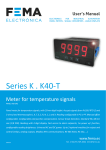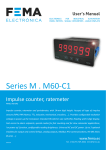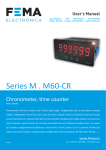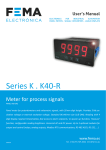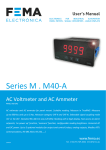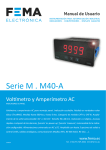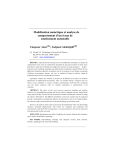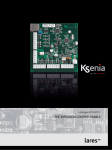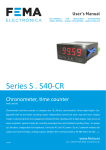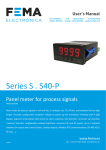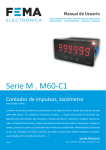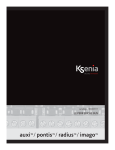Download User`s Manual - K40-485
Transcript
User’s Manual ELECTRONICS FOR INDUSTRIAL AUTOMATION PANEL METERS . SIGNAL CONVERTERS . LARGE DISPLAYS Series K . K40-485 Display for serial protocol RS-485 ASCII PANEL meters Display for ASCII protocol with RS-485 communications bus, with 4 digits and 20 mm digit height, in red color. Reading range from 9999 to -1999 with decimal point. Local or remote alarm control. ‘Watchdog’ function and ‘bus activity’ function. Standard 96 x 48 mm size (1/8 DIN). Fast access to ‘bus ativity’, alarm setpoints and memory of max and min. ‘On power up’ function, configurable reading brightness, password. Universal AC and DC power. Up to 3 optional modules for output and control (relays, analog outputs, Modbus RTU communications, RS-485 ASCII, RS-232, ...) www.fema.es 3802r01 Tel. (+34) 93.729.6004 [email protected] FEMA ELECTRÓNICA . Series K . K40-485 1. Panel meter K40-485 Display for ASCII protocol with RS-485 bus, in 96 x 48 mm (1/8 DIN) format Digital panel meter, with ASCII code repeater function, in 96 x 48 mm size (1/8 DIN) and 4 digits with 20 mm digit height. Reading value, together with decimal point, are controlled via the RS-485 bus, using the ASCII protocol described in this document (see section 1.13). Reading up to 9999 and -1999. Three working modes available allow to work with numbers or alphanumerical symbols. Alarms can be controlled directly from the RS-485 bus or locally from the instrument. • The ‘Process slave’ (see section 1.2) mode works with numerical values, and alarms are controlled locally. • The ‘Full slave’ (see section 1.3) mode works with numerical values, and alarms are controlled from the bus. • The ‘Text’ (see section 1.4) mode works with alphanumerical values, and alarms are controlled from the bus. Bus speed configurable up to 38.400 bps and address configurable from 1 to 31. Accepts a ‘broadcast’ function at address 128. ‘Watchdog’ function detects if communication with the master is lost. ‘Watchdog’ function can display a message on display and control the activation of selected alarms (see section 1.25). Function ‘bus activity’ is a utility for troubleshooting communications (see section 1.26). Function ‘On power up’ defines the alarm state at start-up (see section 1.28.8). Front protection IP54 with optional IP65. Connections by plug-in screw terminals. For industrial applications. • ‘Fast access’ menu to selected functions, accessible with key UP (5) (see section 1.28.6) Memory for maximum and minimum reading, password protection, 5 brightness levels. Index 1. Panel meter K40-485 . . . . . . . . . . . . . . . . . . . . . . 2 1.1 How to order . . . . . . . . . . . . . . . . . . . . . . . . . 3 1.2 ‘Process slave’ mode . . . . . . . . . . . . . . . . . . . . 3 1.3 ‘Full slave’ mode . . . . . . . . . . . . . . . . . . . . . . . 3 1.4 ‘Text’ mode . . . . . . . . . . . . . . . . . . . . . . . . . 3 1.5 Typical application . . . . . . . . . . . . . . . . . . . . . . 3 1.6 Front view . . . . . . . . . . . . . . . . . . . . . . . . . . 4 1.7 Power connections . . . . . . . . . . . . . . . . . . . . . 4 1.8 Start up sequence . . . . . . . . . . . . . . . . . . . . . . 4 1.9 Rear view . . . . . . . . . . . . . . . . . . . . . . . . . . . 4 1.10 Signal connections . . . . . . . . . . . . . . . . . . . . . 4 1.11 Technical specifications . . . . . . . . . . . . . . . . . . 5 1.12 Mechanical dimensions (mm) . . . . . . . . . . . . . . 5 1.13 ASCII protocol - Types of frames . . . . . . . . . . . . . 6 1.14 Frame structure . . . . . . . . . . . . . . . . . . . . . . 7 1.15 Frame examples . . . . . . . . . . . . . . . . . . . . . . 8 1.15.1 Frames ‘WRA’ (35) and ‘OK’ (39) . . . . . . . . . . . 8 1.15.2 Frame ‘ERR’ (38) . . . . . . . . . . . . . . . . . . . . 8 1.15.3 Frames ‘PING’ (32) and ‘PONG’ (33) . . . . . . . . . 8 1.15.4 Frames ‘RD’ (36) and ‘ANS’ (37) . . . . . . . . . . . . 9 1.16 Registers in ‘Process slave’ mode . . . . . . . . . . . . 10 1.17 Registers in ‘Full slave’ mode . . . . . . . . . . . . . . 10 1.18 Registers in ‘Text’ mode . . . . . . . . . . . . . . . . . 11 1.19 CRC calculation . . . . . . . . . . . . . . . . . . . . . . 11 1.20 The ‘Alarm status’ register . . . . . . . . . . . . . . . . 12 1.21 Representable characters . . . . . . . . . . . . . . . . 12 1.22 Messages and errors . . . . . . . . . . . . . . . . . . . 13 1.23 Numerical registers : restrictions . . . . . . . . . . . . 14 1.24 Addresses and ‘broadcast’ . . . . . . . . . . . . . . . 14 1.25 ‘Watchdog’ function . . . . . . . . . . . . . . . . . . . 14 1.26 ‘Bus activity’ function . . . . . . . . . . . . . . . . . . 14 1.27 How to operate the menus . . . . . . . . . . . . . . . 15 1.28 Configuration menu . . . . . . . . . . . . . . . . . . . 16 1.28.1 Initial set-up . . . . . . . . . . . . . . . . . . . . . 16 1.28.2 Bus configuration . . . . . . . . . . . . . . . . . . . 16 1.28.3 Configuration . . . . . . . . . . . . . . . . . . . . . 17 1.28.4 Alarms in ‘Full slave’ and ‘Text’ mode . . . . . . . 17 1.28.5 Alarms in ‘Process slave’ mode . . . . . . . . . . . 18 2 1.28.6 Fast access . . . . . . . . . . . . . . . . . . . . . . 19 1.28.7 Super fast access . . . . . . . . . . . . . . . . . . . 19 1.28.8 Menu ‘On Power Up’ . . . . . . . . . . . . . . . . . 19 1.28.9 Menu ‘Setpoint on bus’ . . . . . . . . . . . . . . . 19 1.28.10 Menu ‘Save to E2PROM’ . . . . . . . . . . . . . . 20 1.28.11 Menu ‘Key LE’ . . . . . . . . . . . . . . . . . . . . 20 1.28.12 Function ‘Password’ . . . . . . . . . . . . . . . . 20 1.28.13 Factory reset . . . . . . . . . . . . . . . . . . . . 20 1.28.14 Firmware version . . . . . . . . . . . . . . . . . . 20 1.28.15 Brightness . . . . . . . . . . . . . . . . . . . . . . 20 1.28.16 Access to optional modules . . . . . . . . . . . . 20 1.29 Factory configuration . . . . . . . . . . . . . . . . . . 21 1.30 Full configuration menu . . . . . . . . . . . . . . . . . 22 1.31 To access the instrument . . . . . . . . . . . . . . . . 24 1.32 Modular system . . . . . . . . . . . . . . . . . . . . . 24 1.33 Precautions on installation . . . . . . . . . . . . . . . 25 1.34 Warranty . . . . . . . . . . . . . . . . . . . . . . . . . 25 1.35 CE declaration of conformity . . . . . . . . . . . . . . 25 2. Output and control modules . . . . . . . . . . . . . . . . . 26 2.1 Module R1 . . . . . . . . . . . . . . . . . . . . . . . . . 26 2.2 Module AO . . . . . . . . . . . . . . . . . . . . . . . . . 26 2.3 Module RTU . . . . . . . . . . . . . . . . . . . . . . . . 27 2.4 Module S4 . . . . . . . . . . . . . . . . . . . . . . . . . 27 2.5 Module S2 . . . . . . . . . . . . . . . . . . . . . . . . . 28 2.6 Modules R2, R4, R6 . . . . . . . . . . . . . . . . . . . . 28 3. Other options . . . . . . . . . . . . . . . . . . . . . . . . . 30 3.1 Option NBT . . . . . . . . . . . . . . . . . . . . . . . . . 30 3.2 Option 65 . . . . . . . . . . . . . . . . . . . . . . . . . 30 4. Accessories . . . . . . . . . . . . . . . . . . . . . . . . . . 31 4.1 THM benchtop housing . . . . . . . . . . . . . . . . . . 31 4.2 Adapter DRA-M . . . . . . . . . . . . . . . . . . . . . . 31 4.3 Adapter KA96 . . . . . . . . . . . . . . . . . . . . . . . 31 4.4 WME housing . . . . . . . . . . . . . . . . . . . . . . . 31 4.5 Protector KIP . . . . . . . . . . . . . . . . . . . . . . . . 31 FEMA ELECTRÓNICA . Series K . K40-485 1.1 How to order Model K40 485 - Power - H -H -L Option 1 - - (85-265 Vac/dc) (11/60 Vdc, 24 Vac, 48 Vac) Option 2 -R1 -AO -RTU -S4 -S2 - Option 3 - Others -NBT -65 (1 relay) (analog output) (Modbus RTU) (RS-485) (RS-232) (empty) (no buttons) (front IP65) 1.2 ‘Process slave’ mode 1.4 ‘Text’ mode In ‘Process slave’ mode, the instrument receives a numerical value though the RS-485 bus. Alarms and analog outputs are locally controlled by the instrument according to the alarm configuration and display value. • Alarms - alarm setpoint is manually configured through the front keypad. Alarm activates or deactivates according to the setpoint value configured and the display value. Relay outputs are associated to alarms. To enable access to setpoint registers through the communications bus, enable the ‘Setpoint on bus’ function (see section 1.28.9). • Analog outputs - analog outputs are manually configured through the front keypad. Analog output value is associated to the display value. In ‘Text’ mode the instrument receives a set of ASCII characters through the RS-485 bus. Characters are not treated as a numerical value, but as a set of individual ASCII characters. Available characters are described in section 1.21. Alarm status are controlled through the RS-485 bus • Alarms - alarm status (‘on’ / ‘off’) is controlled by writing on the alarm status register (see section 1.20). • Analog outputs - analog output are not available in this mode. RS-485 ASCII Alarms Reading RS-485 ASCII K40-485 display in ‘Text’ mode Alarms Display Analog outputs K40-485 display in ‘Process slave’ mode 1.3 ‘Full slave’ mode In ‘Full slave’ mode, display value and alarm status are controlled through the RS-485 bus. • Alarms - alarm status (‘on’ / ‘off’) is controlled by writing on the alarm status register (see section 1.20). • Analog outputs - analog output are manually configured through the front keypad. Analog output signal is associated to the display value. 1.5 Typical application Display of numerical values associated to the production or industrial processes. Display value is controlled through the RS-485 bus using ASCII protocol. Messages are sent by the bus master, usually a PLC or a SCADA system. Relay status can be controlled directly from the PLC or locally from the instrument, depending on the configuration of the instrument. RS-485 ASCII RS-485 ASCII Alarms 4/20mA (isolated) Relay 1 Analog outputs Relay 2 Display K40-485 display in ‘Full slave’ mode 3 FEMA ELECTRÓNICA . Series K . K40-485 1.6 Front view 1.9 Rear view Option 3 Alarms Logo Button ‘LE’ Units Units Button ‘UP’ Button ‘SQ’ ‘Fast access‘ ‘Configuration menu’ Option 1 1 2 3 Option 2 8 9 0 Signal (see section 1.10) Power (see section 1.7) (see section 1.28.6) (see section 1.28) Detail of the plug-in screw terminals provided with the instrument. The instrument is provided with all terminals needed, both male and female. 1.7 Power connections Earth connection - Although a terminal is provided for earth connection, this connection is optional. The instrument does not need earth connection for correct operation nor for compliance with the security regulations. 8 9 0 1.10 Signal connections ~ + ~ - Fuse - To comply with security regulation 61010-1, add to the power line a protection fuse acting as disconnection element, easily accessible to the operator and identified as a protection device. Power ‘H’ fuse 250 mA time lag Power ‘L’ fuse 400 mA time lag 1 2 3 B A GND 1.8 Start up sequence The instrument follows the sequence indicated below at start-up after a power loss : 1. alarm status according to configuration (see section 1.28.8) 2. start up delay according to configuration (see section 1.28.8) 3. all registers initialized to value ‘0’ 3.1 display set to ‘0’ 4. detection of the active working mode ‘Full slave’ or ‘Process slave’ or ‘Text’ 4.1 in ‘Full slave’ mode (see section 1.3) and ‘Text’ mode (see section 1.4) the alarm state is set as explained in ‘1.’ and alarm registers are set to ‘0’ 4.2 in ‘Process slave’ mode (see section 1.2) alarm configuration (setpoint, etc) is compared with display value (‘0’) and each alarm activates or deactivates according to the result of the comparison 5. waits for data reception through the communications bus 4 FEMA ELECTRÓNICA . Series K . K40-485 1.11 Technical specifications ProtocolASCII BusRS-485 Speed from 38.400 bps to 600 bps (19.200 bps by default) Data format 8n1, 8e1, 8o1, 8n2 Address 1 to 31 Bus terminators not included Digits number of digits 4 led 7 segments led colorred digit height 20 mm Reading maximum reading minimum reading decimal point Watchdog Errors 9999 -1999 X.X.X.X Section Fast access yes, configurable 1.28.6 Watchdog yes, configurable 1.25 Scroll in ‘Text’ mode Remote or local alarms configurable 1.28.4 y 1.28.5 ‘watchdog’ alarms configurable 1.25 ‘On Power Up’ yes 1.28.8 Function ‘Bus activity’ yes 1.26 Function ‘Setpoint on bus’ yes, in ‘Process slave’ mode 1.28.9 Memory maximum, minimum 1.28.6 Password configuration block 1.28.12 Alarms in local mode setpoint double setpoint activation delay deactivation delay hysteresis inverted relay deactivation lock 1.28.5 Display brightness 5 levels 1.28.15 configurable from 1 to 120 seconds if communication with the ‘master’ is lost Power power ‘H’ power ‘L’ isolation* consumption 85 to 265 Vac/dc 11 to 60 Vdc and 24/48 Vac 2500 Veff with power ‘H’ 1500 Veff with power ‘L’ *tested for 60 sec. <1.5 W only meter <4.0 W meter with options Configuration 3 buttons front keypad Front protection IP54 standard IP65 optional (see section 3.2) Output and control options relays, analog outputs, serial communications (see section 2) Mechanical mounting panel connections plug-in screw terminal housing material ABS, polycarbonate (V0) weight <150 grams front size 96 x 48 mm (1/8 DIN) panel cut-out 92 x 44 mm depth from panel 91 mm (including terminals) Temperature operation storage warm-up time Functions included from 0 to +50 ºC from -20 to +70 ºC 15 minutes 1.28.3 Table 1 - Functions included 1.12 Mechanical dimensions (mm) 48 96 16 44 75 8 Panel cut-out 92 5 FEMA ELECTRÓNICA . Series K . K40-485 1.13 ASCII protocol - Types of frames The ASCII protocol used defines the following types of frames : • Frame ‘write’ (‘WR’). Identifier 34. Frame to write data into a register. The register number is indicated in the ‘REG’ byte (section ‘Header’). Bytes ‘D0’ to ‘Dn’ (section ‘Data’) contain the data to write. • Frame ‘write with acknowledgment’ (‘WRA’). Identifier 35. Frame to write data into a register, with acknowledgment of success. The register number is indicated in the ‘REG’ byte (section ‘Header’). Bytes ‘D0’ to ‘Dn’ (section ‘Data’) contain the data to write. The instrument will reply with a ‘ok’ frame (‘OK’) if the writing action succeeded, or with a ‘error’ frame (‘ERR’) if the writing action did not succeed. • Frame ‘ok’ (‘OK’). Identifier 39. Informs that the action of writing data into a register, was successful. This is a response frame to a ‘write with acknowledgment’ frame (‘WRA’). • Frame ‘error’ (‘ERR’). Identifier 38. Informs that the data read (‘RD’) or data write (‘WRA’) did not succeed. The error code is codified into the ‘REG’ byte (section ‘Header’). For a list of error codes see section 1.22. • Frame ‘read’ (‘RD’). Identifier 36. Frame to request the data value of a register. The register number is indicated in the ‘REG’ byte (section ‘Header’). • Frame ‘answer’ (‘ANS’). Identifier 37. Response frame containing the requested data of a ‘read’ frame. The register number is indicated inthe ‘REG’ byte (section ‘Header’). Bytes ‘D0’ to ‘Dn’ (section ‘Data’) contain the requested data. • Frame ‘ping’ (‘PING’). Identifier 32. Frame ‘ping’ is a request of existence to the remote instrument. The remote instrument will answer with a ‘pong’ frame. • Frame ‘pong’ (‘PONG’). Identifier 33. Frame ‘pong’ is a response frame to a ‘ping’ frame. It confirms the existence of the remote instrument. • Frame ‘write’ (‘WR’) Example, write of the display value. Units • Frame ‘write with acknowledgment’ (‘WRA’) • Frame ‘ok’ (‘OK’) ... • ... or frame ‘error’ (‘ERR’) Example, write of the display value with request of confirmation. Confirmation is a ‘ok’ frame or a ‘error’ frame. Units • Frame ‘read’ (‘RD’) • Frame ‘answer’ (‘ANS’) ... • ... or frame ‘error’ (‘ERR’) Example, reading of the display value and response from the remote instrument with the value of the display register. Units • Frame ‘ping’ (‘PING’) Example, confirmation that the remote instrument exists and is operative. Answer is a ‘pong’ frame. • Frame ‘pong’ (‘PONG’) Units 6 FEMA ELECTRÓNICA . Series K . K40-485 1.14 Frame structure Header Data STX ID RSV FROM TO REG RSV LONG 2 x 32 x x x 32 n+1 0 1 2 3 4 5 6 7 D0 D1 8 9 Trail ... Dn CRC x 3 ... n+7 n+8 n+9 [data] ETX The protocol frames are structure with a header section (‘Header’), a data section (‘Data’) and a end of frame section (‘Trail’). Section ‘Trail’ Contains the ‘CRC’ code and the end of frame byte (‘ETX’). Section ‘Header’ Contains the start of frame byte (‘STX’), the frame identifier (‘ID’), the sender (‘FROM’) and destination (‘TO’) addresses, the register number (‘REG’) and the length (‘LONG’) of the ‘Data’ section. ‘Real value’ and ‘Frame value’ In order to use frame characters that are representable and easily recognizable on screen, the protocol codifies the values before introducing them into the frame. The following nomenclature is defined : • ‘real value’ is the value of the field without codification • ‘frame value’ is the value codified Section ‘Data’ Contains the data of the register (‘REG’). Field Description Size Position Real value Frame value STX Start of frame 1 byte 0 does not apply 2 ID Type of frame 1 byte 1 (see section 1.13) real_value RSV Reserved 1 byte 2 0 32 FROM Sender address 1 byte 3 0 (‘Master’) / 1 a 31 (‘Slave’) 32 + real_value TO Destination address 1 byte 4 0 (‘Master’) / 1 a 31 (‘Slave’) 128 (‘broadcast’) 32 + v REG Register number 1 byte 5 see sections 1.16, 1.17 and 1.18 32 + real_value RSV Reserved 1 byte 6 0 32 LONG Length of ‘Data’ section 1 byte 7 n (between 0 and 32) 32 + real_value D0 … Dn Data n bytes 8 a n+7 number 0 to 9 decimal point sign (+/-) ASCII code for number (48 to 57) ASCII code for dot (46) ASCII code for ‘+’ (43) ASCII code for ‘-’ (45) CRC CRC calculated value 1 byte n+8 does not apply (see section 1.19) ETX End of frame 1 byte n+9 does not apply 3 Table 2 - Description of the ASCII frame bytes 7 FEMA ELECTRÓNICA . Series K . K40-485 1.15 Frame examples 1.15.1 Frames ‘WRA’ (35) and ‘OK’ (39) Example - The ‘Master’ (address ‘0’) sends a write frame, with request of acknowledgment, (frame ‘WRA’) with value ‘65.43’ to register number ‘0’ (display value) to the ‘Slave’ with address ‘28’. The ‘Slave’ answers to the ‘Master’ with a ‘ok’ frame (‘OK’). In case of error, it will answer with a ‘error’ frame (‘ERR’). Header Data Trail STX ID RSV FROM TO REG RSV LONG D0 D1 D2 D3 D4 D5 CRC ETX 2 35 32 32 60 32 32 38 43 54 53 46 52 51 58 3 Start WRA --- 0 28 0 --- 6 +65.43 CRC Stop Header Trail STX ID RSV FROM TO REG RSV LONG CRC ETX 2 39 32 60 32 32 32 32 57 3 Start OK --- 28 0 0 --- 0 CRC Stop 1.15.2 Frame ‘ERR’ (38) Example - The ‘Slave’ with address ‘28’ answers to the ‘Master’ (address ‘0’) with an error frame (frame ‘ERR’) indicating that the register is unknown (‘UNKNOWN_REGISTER’, error code ‘1’). The error code is indicated in the ‘REG’ byte. For a list of error codes see section 1.22. Header Trail STX ID RSV FROM TO REG RSV LONG CRC ETX 2 38 32 60 32 33 32 32 57 3 Start ERR --- 28 0 1 --- 0 CRC Stop 1.15.3 Frames ‘PING’ (32) and ‘PONG’ (33) Example - The ‘Master’ (address ‘0’) requests confirmation of existence to the ‘Slave’ at address ‘22’ (frame ‘PING’) and the ‘Slave’ answers to the ‘Master’ with a ‘PONG’ frame. Header Trail STX ID RSV FROM TO REG RSV LONG CRC ETX 2 32 32 32 54 32 32 32 52 3 Start Ping --- 0 22 0 --- 0 CRC Stop Header 8 Trail STX ID RSV FROM TO REG RSV LONG CRC ETX 2 33 32 54 32 32 32 32 53 3 Start Pong --- 22 0 0 --- 0 CRC Stop FEMA ELECTRÓNICA . Series K . K40-485 1.15 Frame examples (cont.) 1.15.4 Frames ‘RD’ (36) and ‘ANS’ (37) Example - The ‘Master’ (address ‘0’) requests the value of register number ‘0’ (display value) to the ‘Slave’ with address ‘28’ (frame ‘RD’) and the ‘Slave’ answers to the ‘Master’ with a frame (‘ANS’) that contains the value requested (65.43). For compatibility reasons, de instrument will always answer with a 6 digit value, filling with left zeros the additional positions. Header Trail STX ID RSV FROM TO REG RSV LONG CRC ETX 2 36 32 32 60 32 32 32 58 3 Start RD --- 0 28 0 --- 0 CRC Stop STX ID RSV FROM TO REG RSV LONG D0 D1 D2 D3 D4 D5 D6 D7 CRC ETX 2 37 32 60 32 32 32 40 43 48 48 54 53 46 52 51 50 3 Start ANS --- 28 0 0 --- 8 +0065.43 CRC Stop Header Data Trail 9 FEMA ELECTRÓNICA . Series K . K40-485 1.16 Registers in ‘Process slave’ mode List of registers accessible (see Table 3) for an instrument configured in ‘Process slave’ mode. and write access to these registers through the bus, see section 1.28.9. • register 0 contains the value to show on display. It is a numerical value, with or without polarity at the first character (‘+’ or ‘-’) and with a single decimal point, or without decimal point. • write frames to the setpoint registers when they are disabled will return error 8 ‘Read only register’. Example 1 : send characters ‘+’ ‘7’ ‘4’ ‘.’ ‘6’ ‘1’ to read on display ‘74.61’ • to save into the E2PROM the values written through the bus into these registers, (values will be maintained incase of power loss) enable parameter ‘E2Pr’ (see section 1.28.10). Example 2 : send characters ‘-’ ‘0’ ‘4’ ‘6’ to read on display ‘-46’ • after power loss, the instrument will start-up with all registers initialized to a value of ‘0’ (see section 1.8). • registers 3, 4 and 5 contain the setpoint values for alarms 1, 2 and 3. By default, write access to these registers is disabled (setpoint value is modified through the front keypad). To enable read • the alarm status is accessible at register 6. The format of this register is explained at section 1.20. Register number Name Type Description 0 Display 1 Reserved --- --- 2 Reserved --- --- 3 Setpoint 1 R / W* 4 Setpoint 2 R / W* 5 Setpoint 3 R / W* 6 Alarm status (R=Read, W=Write) R / W R Register with the display value, including the decimal point and polarity. Value of the alarm setpoint. *Write to these registers is disabled by default (see section 1.20). Status of alarms 1, 2 and 3 (see section 1.20). Table 3 - Registers in ‘Process slave’ mode 1.17 Registers in ‘Full slave’ mode List of registers accessible (see Table 4) for an instrument configured in ‘Full slave’ mode. • the alarm status is accessible at register 6. The format of this register is explained at section 1.20. • register 0 contains the value to show on display. It is a numerical value, with or without polarity at the first character (‘+’ or ‘-’) and with a single decimal point, or without decimal point. • after power loss, the instrument will start-up with all registers initialized to a value of ‘0’ (see section 1.8). Example 1 : send characters ‘+’ ‘7’ ‘4’ ‘.’ ‘6’ ‘1’ to read on display ‘74.61’ Example 2 : send characters ‘-’ ‘0’ ‘4’ ‘6’ to read on display ‘-46’ Register number Name 0 Display 1 Reserved --- --- 2 Reserved --- --- 3 Reserved --- --- 4 Reserved --- 5 Reserved --- 6 Alarm status Table 4 - Registers in ‘Full slave’ mode 10 Type Description (R=Read, W=Write) R / W R / W Register with the display value, including the decimal point and polarity. Status of alarms 1, 2 and 3 (see section 1.20). FEMA ELECTRÓNICA . Series K . K40-485 1.18 Registers in ‘Text’ mode List of registers accessible (see Table 5) for an instrument configured in ‘Text’ mode. • if the register contains more than 6 characters, the ‘scroll’ mode is activated (see section 1.28.3). • register 0 contains the value to show on display. It is an alphanumerical value. The register can contain up to 71 characters. • the alarm status is accessible at register 6. The format of this register is explained at section 1.20. • acceptable characters are indicated at Table 7. • after power loss, the instrument will start-up with all registers initialized to a value of ‘0’ (see section 1.8). • character ‘+’ is represented as an empty space. • characters received not included in this table, are shown as 3 horizontal stripes on display ( ). Register number Name Type Description 0 Display 1 Reserved --- --- 2 Reserved --- --- 3 Reserved --- --- 4 Reserved --- 5 Reserved --- 6 Alarm status (R=Read, W=Write) R / W R / W Register with the alphanumerical characters to represent on display. See section 1.21 for a list of representable characters. Status of alarms 1, 2 and 3 (see section 1.20). Table 5 - Registers in ‘Text’ mode 1.19 CRC calculation The frame_value for the CRC byte is calculated based on the frame_ values (see section 1.14) of the bytes from the ‘Header’ and ‘Data’ sections. Calculation consists on a ‘XOR’ function from byte ‘0’ (‘STX’) to the last data byte (byte Dn). • If the CRC calculated value is lower than ‘32’, it is normalized with the function ‘complement to 1’. CRC0=STX ^ ID ^ RSV ^ FROM ^ TO ^ REG ^ RSV ^ LONG ^ D0 ^...^ Dn • Si (CRC0<32) -> CRC=!CRC0 (complement_to_1 function) • Si (CRC0>31) -> CRC=CRC0 //example of CRC calculation in C language int8 Calculate_CRC(int8 CRC_Position) { int8 i,CRC=0; for(i=0;c<CRC_Position;c++) { crc=crc ^ frame[i]; } if(crc<32) CRC=~CRC; return(CRC); } 11 FEMA ELECTRÓNICA . Series K . K40-485 1.20 The ‘Alarm status’ register The ‘Alarm Status’ register (register 6) is available as a read_only register for the ‘Process slave’ mode and as a read/write register for the ‘Full slave’ and ‘Text’ modes. This register contains the status of alarms 1, 2 and 3. Status is active or inactive. The ‘Alarm Status’ register is 1 character (1 byte) register, with possible values from ‘0’ to ‘7’. The alarm status for each value are indicated at Table 6. Note that the ‘Alarm Status’ register contains a value that is the ASCII code of a number from ‘0’ to ‘7’. The reason is to maintain the protocol structure of transmitting ASCII protocols. Note that the value represented by this character is the binary code representing the status of the alarms. for example, ASCII code 53 represents number ‘5’, which in binary is ‘0101’, and corresponds with alarm status 3, 2 and 1 in ‘on’, ‘off’ and ‘on’. Register value ASCII character Alarm 3 status Alarm 2 status Alarm 1 status ‘0’ 48 off off off ‘1’ 49 off off on ‘2’ 50 off on off ‘3’ 51 off on on ‘4’ 52 on off off ‘5’ 53 on off on ‘6’ 54 on on off ‘7’ 55 on on on Table 6 - Register ‘Alarm Status’. 1.21 Representable characters Representable characters are indicated in the following table. • In numerical modes (‘Full slave’ and ‘Process slave’ modes) only numbers from ‘0’ to ‘9’, decimal point (‘.’ or ‘,’) and polarity (‘+’ or ‘-’) are representable. Missing polarity is assimilated to positive polarity. Character ‘+’ is not represented on display. • In ‘Text’ mode all characters in the table are representable. Character ‘+’ is represented as a blank space. Characters not included in this table are represented with 3 horizontal stripes( ). • Character ‘.’ and character ‘,’ represent both the decimal point. Representable characters Character Display Cod. ASCII Character 0 48 1 Display Cod. ASCII Character Aa 65 / 97 49 Bb 2 50 3 Display Cod. ASCII Character Kk 75 / 107 Tt 84 / 116 66 / 98 Ll 76 / 108 Uu 85 / 117 Cc 67 / 99 Mm 77 / 109 Vv 86 / 118 51 Dd 68 / 100 Nn 78 / 110 Ww 87 / 119 4 52 Ee 69 / 101 Ññ 165 / 164 Xx 88 / 120 5 53 Ff 70 / 102 Oo 79 / 111 Yy 89 / 121 6 54 Gg 71 / 103 Pp 80 / 112 Zz 90 / 122 7 55 Hh 72 / 104 Qq 81 / 113 ‘.’ ‘,’ 44 / 46 8 56 Ii 73 / 105 Rr 82 / 114 - 45 9 57 Jj 74 / 106 Ss 83 / 115 + Table 7 - Representable characters. *Character ‘+’ is accepted as polarity but has no representation on display.. 12 Display *(not representable) Cod. ASCII 43 FEMA ELECTRÓNICA . Series K . K40-485 1.22 Messages and errors Error messages are grouped into those related to the instrument, and those related to the frames • errors related to the instrument are shown on display (see Table 8). • error messages related to the communications protocol are informed into the response frame (see Table 9). Error messages are generated only as answers to frames ‘WRA’ or ‘RD’. No anser frames with error informations will be generated for ‘WR’ frames. Messages and errors shown on display ‘Err.1’ incorrect password. ‘Err.2’ at ‘oPt.X’ menu entry. Installed module is not recognized. ‘Err.W’ ‘Watchdog’ error ‘9999’ + flashing mode. Reading is in overrange. ‘-1999’ + flashing mode. Reading is in underrange. Table 8 - Messages and error codes related to the instrument Messages and errors related to the ASCII protocol frames 1 ‘Unknown register’ The requested register does not exist. 4 ‘CRC error’ The received frame has a CRC error. 6 ‘Empty Data’ A ‘WRA’ frame has been received without ‘DATA’ section. Error is not sent in case of frames ‘WR’ 7 ‘Reserved register’ Requested action is directed to a reserved register. Action is ignored. 8 ‘Read only register’ A write action is directed to a read-only register. 9 ‘Frame error’ The frame ID is not known. 10 ‘First char error’ When writing on numerical registers, first character must be a number or polarity (‘+’ or ‘-‘). In case of other characters, this error is generated. 11 ‘Format error’ When writing on numerical registers, the value contains characters not representable, which prevents conversion to a number. Representable characters are numbers from 0 to 9, polarity (‘+’ and ‘-’) at the beginning of the register, and one decimal point. 12 ‘Out of range’ When writing on numerical registers, the number is out of the representable range of numbers accepted by the instrument. For example, 6 digits are being received and ths instrument allows for a maximum of 4. 13 ‘String error’ When writing on text registers, the ‘DATA’ field is too long (75 bytes, 75 bytes characters) Table 9 - Messages and error codes related to the ASCII protocol frames 13 FEMA ELECTRÓNICA . Series K . K40-485 1.23 Numerical registers : restrictions Registers which must contain a numerical value, are controlled to assure that the value received from the frame is a true numerical value. If controls are successful, the value is saved into the register. Otherwise, an error is generated. Registers which must contain numerical values are the following : • ‘Display’ register • ‘Setpoint 1’, ‘Setpoint 2’ and ‘Setpoint 3’ registers When writing data into these registers, the instrument converts the ASCII characters received on the ‘DATA’ section of the frame, to a numerical value. The following controls are applied, in the order indicated below : • Section ‘DATA’ can not be empty of characters. It generates an error 6 ‘Empty Data’. • First character must be ‘+’, ‘-’, ‘.’, ‘,’ or a number from ‘0’ to ‘9’. It generates error 10 ‘First char error’. • Section ‘DATA’ must contain maximum one decimal point. It generates error 11 ‘Format error’. • Section ‘DATA’ can contain only characters from ‘0’ to ‘9’ or decimal point (‘,’ o ‘.’). First character has already been controled and is not controlled again. If other character is found, it generates error 11 ‘Format error’. • If section ‘DATA’ does not contain decimal point, its maximum length is 7 characters. If section ‘DATA’ contains decimal point, its maximum length is 8 characters. Larger data generates error 12 ‘Out of range’. • Conversion from ASCII characters to a number. Decimal point is separated from the number, which is treated as an integer. Examples : possible conversions are as follows: ‘1234’ is read on display as 1234 ‘-1234’ is read on display as -1234 ‘-12.34’ is read on display as -12.34 ‘+.995’ is read on display as 0.995 ‘+0.995’ is read on display as 0.995 ‘0.995’ is read on display as 0.995 ‘.995’ is read on display as 0.995 ‘+0027’ is read on display as 27 ‘+27’ is read on display as 27 ‘27’ is read on display as 27 • The numerical integer is sent to display. If the number is higher than the maximum number that can be represented by the display, it generates an error 12 ‘Out of range’. Example : ‘-67.89’ is not representable on display, because minimum display is -1999. Instrument will generate an ‘Out of range’ error. ‘Display’ register is not updated. It generates an answer frame 12 ‘Out of range’ if the writing was requested with a ‘WRA’ frame. Note : character ‘.’ and ‘,’ are equivalent and both are associated to the decimal point. 14 1.24 Addresses and ‘broadcast’ Addresses available to assign to the intruments are from 1 to 31. Address 128 is a ‘broadcast’ address. Instruments will accept and process frames when destination address of the frame matches its own address. All frames addressed to destination address 128 will be accepted by all instruments, independent of its own address. Instruments will not generate answer frames when destination address is 128. • a ‘ping’ (‘PING’) frame to destination address 128 will not generate answer • a ‘write with aknowldgement’ (‘WRA’) frame to destination address 128 will not generate answer • a ‘read’ (‘READ’) frame to destination address 128 will not generate answer • a frame to destination address 128 which contains an error (a CRC error for example) will not generate answer 1.25 ‘Watchdog’ function The ‘watchdog’ function activates an error state in case of loss of communication with the ‘master’. To configure the ‘watchdog’ indicate the maximum time accepted to wait between two frames received. If this time exceeds, the ‘watchdog error’ activates. Receiving a correct frame resets the ‘watchdog’ timer. Frames that can reset the ‘watchdog’ timer are those addressed to the ‘slave’ instrument. These frames must conform to the indicated ASCII protocol and have a correct CRC. If the function or register or coil indicated in the frame is not correct, the ‘slave’ instrument will still reset the ‘watchdog’ timer. It will also reply with the corresponding error message. The internal alarms of the instrument can be associated to the ‘watchdog’. In case of ‘watchdog’ activation, the associated alarm will also activate. Display can also be configured to show an error message in case of ‘watchdog’ error. It can be configured for flashing, dash (‘------’) or to show message ‘Err.W’. See sections 1.28.4 and 1.28.5 for information on alarm configuration and section 1.28.3 for information on ‘watchdog’ configuration. 1.26 ‘Bus activity’ function ‘Bus activity’ function is a detector of electrical activity on the bus. The function is to help when connecting the instrument to the bus for the first time. It provides information on wether there is electrical activity on the bus or not. The ‘Bus activity’ function is visible in the form of a counter increasing its value on the display. It indicates that the UART is detecting information bytes on the bus. This detection means that there are data on the bus, and that it conforms to the configured speed and data format. ‘Bus activity’ function is accessible at key UP (5), when enabled as indicated in section 1.28.6. FEMA ELECTRÓNICA . Series K . K40-485 1.27 How to operate the menus Example of operation inside the ‘configuration menu’. The instrument has two menus accessible to the user : ‘Configuration menu’ (key SQ) (<) ‘Fast access’ menu (key UP) (5) (1) (6) (5) Configuration menu The ‘configuration menu’ modifies the configuration parameters to adapt the instrument to the application needs. To access the ‘configuration menu’ press for 1 second the SQ (<) key. This access can be blocked by activating the ‘Password’ (‘PASS’) function. While operating the ‘configuration menu’, the alarm status is ‘hold’ to the status they had before accessing the menu, and the output and control modules remain in ‘error’ state. When leaving the ‘configuration menu’, the instrument applies a system reset, followed by a brief disconnection of the alarms and the output and control modules. Functionality is then recovered. For a detailed explanation on the ‘configuration menu’ see section 1.28, and for a full view of the ‘configuration menu’ structure see section 1.30. 1. The SQ (<) key enters into the ‘working mode’. (2) Working mode (3) (6) (3) (3) 2. The SQ (<) key enters into the ‘Proc’ option menu. (3) 3. The UP (5) key moves through the menu options. (5) 4. The SQ (<) key selects the desired range and returns to the ‘ModE’ menu. 5. The LE (3) key leaves the actual menu level and moves to the previous menu level. 6. The LE (3) key leaves the ‘configuration menu’. Changes are applied and saved at this moment. ‘Fast access’ menu The ‘fast access’ menu is an operator configurable menu, providing fast and direct access to the most usual functions of the instrument with a single key pad stroke. Press key UP (5) to access this menu. See section 1.28.6 for a list of functions eligible for ‘fast access’ in this instrument. The ‘Password’ (‘PASS’) function does not block access to this menu. Accessing and modifying parameters in the ‘fast access’ menu does not interfere with the normal functionality of the instrument, and it does not generate any system reset when validating the changes. Front key pad description Key SQ (<) - press the SQ (<) key for 1 second to access the ‘configuration menu’. Inside the menu, the SQ (<) key functions as a ‘ENTER’ key. It selects and accesses the menu option currently displayed. At menus with numerical value entries, it validates the number displayed. Key UP (5) - the UP (5) key gives access to the ‘fast access’ menu. Inside the menus, it moves vertically through the different menu options. At menus with numerical value entries, it modifies the digit selected by increasing its value to 0, 1, 2, 3, 4, 5, 6, 7, 8, 9. Key LE (3) - inside the menus, the LE (3) key functions as the ‘ESCAPE’ key. It leaves the selected menu, and eventually, will leave the whole menu. When leaving the ‘configuration menu’ with the LE (3) key, the changed parameters are activated. At menus with numerical value entries, the LE (3) key allows to select the active digit. To modify the value of the selected digit use the UP (5) key. Menu ‘rollback’ After 30 seconds without interaction from the operator, the instrument will rollback and leave the ‘configuration menu’ or the ‘fast access’ menu. All changes will be discarded. 15 FEMA ELECTRÓNICA . Series K . K40-485 1.28 Configuration menu Press ‘SQ’ (<) for 1 second to access the ‘configuration menu’. For a description on how to operate inside the menus see section 1.27. For a full vision of the ‘configuration menu’ structure see section 1.30. ‘Process slave’ mode Working mode ‘Full Slave’ mode 1.28.1 Initial set-up The instrument can work in two different modes called ‘Process Slave’, ‘Full slave’ and ‘Text’. In all three modes, information on display is received through the communications bus. The modes differ in how information received is interpreted and how alarms are managed. • ‘‘Process slave’ mode’ (‘Proc’) - instrument receives a numerical value through the communications bus, to represent on display. Alarms, analog outputs and other control modules are controlled based on local configuration and actual display value. Alarm activation or deactivation depends on the display value and the local alarm configuration. ‘Text’ mode • ‘‘Full slave’ mode’ (‘F.SLV’) - instrument receives a numerical value through the communications bus, to represent on display. Alarms are also controlled by activation and deactivation orders received from the communications bus. Analog outputs and other control modules are controlled based on local configuration and actual display value. • ‘‘Text’ mode’ (‘tEXt’) - instrument receives ASCII characters through the communications bus, to represent on display. Alarms are also controlled by activation and deactivation orders received from the communications bus. Analog outputs and other control modules are controlled based on local configuration and actual display value. Configuration menus for each modes are slightly different. Following is a description of the full configuration menu, with a note when the menu entry applies only to one of the modes. Bus configuration Speed (en kbps) from 38.4 Kbps ... ... to 600 bps 1.28.2 Bus configuration Assigns bus speed and data format inside the ‘Bus configuration’ (‘buS’) menu. • en ‘Speed’ (‘bAud’) select the bus speed (in Kbps). • en ‘Format’ (‘bitS’) select the data format between ‘8n1’, ‘8e1’, 8o1’ and ‘8n2’. 8 bits, no parity, 1 stop Format 8 bits, even parity, 1 stop 8 bits, odd parity, 1 stop 8 bits, no parity, 2 stop 16 FEMA ELECTRÓNICA . Series K . K40-485 1.28 Configuration menu (cont.) 1 to 31 Configuration 1.28.3 Configuration In configuration menu assign the instrument address, the ‘watchdog’ time, define the behavior in case of error, and configure the scroll function for ‘Text’ mode. Local address • at ‘Local address’ (‘Addr’) assign the address of the instrument in the bus. Values from 1 to 31. Watchdog waiting time Watchdog Flash On error Dashes (----) • at ‘Watchdog’ (‘W.doG’) define the maximum waiting time between frames, in seconds. If time between received frames exceeds the defined value, an error state will be generated and the function ‘watchdog’ will activate (see section 1.25). Select ‘0’ to disable the ‘watchdog’. Maximum value 120 seconds. • at ‘On error’ (‘on.Er’) configure the action in case of watchdog error. - select ‘Flash’ (‘FLSh’) to activate the display flash. - select ‘Dashes’ (‘dASh’) to activate dashes (‘----’) on display. Watchdog error do nothing - select ‘Watchdog error’ (‘Err.W’) to activate message ‘Err.W’ on display. - select ‘do nothing’ (‘nonE’) to perform no action. • the ‘Scroll’ (‘ScrL’) entry applies only to ‘Text’ mode, select ‘on’ to activate the scroll to represent messages with a number of characters higher than the number of display digits. For example, a message with characters ‘Abcd1234’ will be represented as : Scroll function in ‘Text’ mode Text scroll 1.28.4 Alarms in ‘Full slave’ and ‘Text’ mode Alarms in ‘full slave’ mode Alarm 1 Remote Watchdog Alarm 2 Remote Menu available only in ‘Full slave’ and ‘Text’ modes. Alarms are remotely controlled from the communications bus. Each alarm can be also configured to activate when ‘watchdog’ error activates (see section 1.25). This alarm can then control a signal showing that communication is lost to the operator. For alarm configuration in ‘Process slave’ mode see section (see section 1.28.5). Watchdog Alarm 3 Remote Watchdog 17 FEMA ELECTRÓNICA . Series K . K40-485 1.28 Configuration menu (cont.) 1.28.5 Alarms in ‘Process slave’ mode Alarms in ‘process slave’ mode Alarm 1 Menu available only in ‘Process slave’ mode. Alarms are locally controlled from the instrument. Operator must manually configure the alarm parameters for each alarm. To configure an alarm, enter into the alarm menu (‘ALr1’, ‘ALr2’ or ‘ALr3’) and configure the following parameters : Active • select ‘Active’ (‘Act’) to ‘on’ • at ‘Alarm type’ (‘TypE’) select the alarm to act as a maximum type alarm (‘MAX’) or a minimum type alarm (‘MIn’). The maximum type alarm (or minimum type alarm) activates when the display value is higher (or lower) than the setpoint value. Select ‘watchdog’ (‘W. doG’) alarm to activate the alarm when the ‘watchdog’ error activates (see section 1.25). • at ‘Setpoint’ (‘SEt’) enter the value for the alarm activation point. This parameter is eligible for configuration through the ‘Fast access’ menu (see section 1.28.6). • configure the hysteresis value at ‘Hysteresis’ (‘hySt’). The hysteresis applies to the deactivation process of the alarm. The alarm deactivates when the reading has passed the setpoint value plus the hysteresis value. Hysteresis helps to avoid repetitive switching of the alarm relays, due to fluctuating input signals around the setpoint. • at ‘Activation delay’ (‘dEL.0’) configure the delay to apply before alarm activation. The activation delay starts counting when the setpoint value is passed. Value from 0.0 to 99.9 seconds. • at ‘Deactivation delay’ (‘dEL.1’) configure the delay to apply before alarm deactivation. The deactivation delay starts counting when the setpoint value plus the hysteresis value, is passed. Value from 0.0 to 99.9 seconds. • to work with ‘windowed alarms’ (see graphical example below) activate ‘Setpoint 2’ (‘SEt2’) to ‘on’ and then configure the desired second setpoint value. Second setpoint must always be higher in value than the first setpoint. • the ‘Relay inverted’ (‘r.Inv’) parameter inverts the normal relay connections. When set to ‘on’ the relay will be active when alarm is inactive. For security applications where an inactive relay controls the shutdown of the system. • the ‘Locked alarm’ (‘A.Lck’) parameter disables the automatic deactivation of the alarm. Alarm deactivation must be performed manually, by pressing the ‘LE’ front button (see section 1.28.11) Alarm type Setpoint Hysteresis Activation delay Dectivation delay Setpoint 2 Inverted relay Locked alarm Reading setpoint hysteresis Time Alarm as maximum, no hysteresis, no delays on off Reading Setpoint 2 Time Setpoint 1 on off activation delay on off 18 Alarm as maximum, with hysteresis and delays Time deactivation Time delay Alarm as minimum, no hysteresis, no delays Time on off Alarm as minimum, with double setpoint, no hysteresis, no delays Time FEMA ELECTRÓNICA . Series K . K40-485 1.28 Configuration menu (cont.) 1.28.6 Fast access The ‘UP’ (5) key at the front of the instrument gives access to a list of functions configurable by the operator. See section 1.27 for an explanation on how to operate the ‘fast access’ menu. Tools Key UP (‘fast access’) Bus activity The ‘Key UP (Fast access)’ (‘K.uP’) menu allows to select which functions will be accessible through the ‘fast access’ menu. Select ‘on’ to activate each function. Memory of maximum • the ‘Bus activity’ (‘buS.A’) helps to visualize activity in the communications bus (see section 1.26). • the ‘Memory of maximum’ (‘MAX’) or ‘Memory of minimum’ (‘MIn’) functions allow to visualize the maximum or minimum reading value stored in memory. To reset this value, visualize the memory value at the ‘fast access’ menu with key UP (5) and when message ‘rSt’ is displayed, press (<) to reset. Memory of minimum Setpoint 1 Setpoint 2 • the ‘Setpoint 1’ (‘ALr1’) function allows to visualize and modify the alarm 1 setpoint through the ‘fast access’ menu. Available only in ‘Process slave’ mode. Setpoint 3 • the ‘Setpoint 2’ (‘ALr2’) function allows to visualize and modify the alarm 2 setpoint through the ‘fast access’ menu. Available only in ‘Process slave’ mode. • the ‘Setpoint 3’ (‘ALr3’) function allows to visualize and modify the alarm 3 setpoint through the ‘fast access’ menu. Available only in ‘Process slave’ mode. Address • the ‘Address’ (‘Addr’) function allows to visualize the address of the instrument. 1.28.7 Super fast access On power-up Delay Alarm 1 Seconds If only a single function is selected for the ‘fast access’ menu, pressing the the ‘UP’ (5) key will shortly display the function name and then automatically jump to the function value. 1.28.8 Menu ‘On Power Up’ Alarm 2 Alarm 3 Setpoint on bus The ‘On Power Up’ (‘on.Pu’) menu configures functions to apply at start-up. It applies only to instrument restart after power loss. It does not apply to instrument restart due to change in configuration (see section 1.8). • parameter ‘Delay’ (‘dLAy’) assigns a waiting time in seconds to be applied at start-up. During this waiting time, the display shows all decimal points flashing (see section 1.8) and no action is performed. Delay value between 0 and 200 seconds. • parameters ‘Alarm 1’ (‘ALr1’), ‘Alarm 2’ (‘ALr2’) and ‘Alarm 3’ (‘ALr3’) define the alarm status at instrument start-up (see section 1.8). 1.28.9 Menu ‘Setpoint on bus’ Available only in ‘Process slave’ mode. Alarm configuration in ‘Process slave’ mode is done through the front keypad. Enable the ‘Setpoint on bus’ (‘StP.b’) function to ‘on’ to enable alarm setpoint registers accessible from the communications bus. By default this function is ‘oFF’. Nota : value written in the ‘alarm’ register updates the alarm setpoint. But manual modification of alarm setpoint does not update the ‘alarm’ register. 19 FEMA ELECTRÓNICA . Series K . K40-485 1.28 Configuration menu (cont.) 1.28.10 Menu ‘Save to E2PROM’ SAve to E2PROM By default, saving values to the E2PROM from the communciations bus, is disabled. Select ‘on’ to save updates on the setpoint values also to the E2PROM (see section 1.28.9). This parameter is set to ‘oFF’ by default because E2PROM memories have a typical live of 100.000 saving cycles. This value is clearly enough for manual changes on the setpoint, but from a communications bus, this value can be achieved very fast if the sender is not accurate enough in controlling the send frames. Remote no function Key ‘LE’ 1.28.11 Menu ‘Key LE’ The ‘LE’ (3) key at the front of the instrument can be configured to activate several functions. Only one function can be assigned to the ‘LE’ (3) key Alarm unlock • the ‘No function’ (‘nonE’) value assigns no function. • the ‘Alarm unlock’ (‘A.Lck’) value assigns the manual unlock of the alarms function, for instruments with the ‘Locked alarms’ (‘A.Lck’) function activated (see section 1.28.5) Password 1.28.12 Function ‘Password’ At the ‘Password’ (‘PASS’) menu select a 6 digit code to block access to the ‘configuration menu’. Instrument configuration will not be accessible to non authorized personnel. To activate the ‘Password’ select ‘on’ and introduce the code. Factory reset Version Minimum Brightness 1.28.13 Factory reset Standard Maximum Configuration menu for the module installed at Opt.1 Option 1 Configuration menu for the module installed at Opt.2 Option 2 Configuration menu for the module installed at Opt.3 Option 3 The code will be requested when trying to access the ‘configuration menu’ (key ‘SQ’ (<)). The ‘fast access’ menu is not password protected. At the ‘Factory reset’ (‘FAct’) menu, select ‘yes’ to load the default factory configuration for the instrument (see section 1.29). 1.28.14 Firmware version The ‘Version’ (‘VEr’) menu informs of the current firmware version installed in the module. 1.28.15 Brightness At the ‘Brightness’ (‘LIGh’) menu select the light intensity for the front leds. With this function it is possible to adapt the instrument to the environment light intensity. 1.28.16 Access to optional modules Menus ‘OPt.1’, ‘OPt.2’ and ‘OPt.3’ give access to the ‘configuration menus’ of the output and control modules installed at slots Opt.1, Opt.2 and Opt.3. See section 2 for a list of output and control modules available for each slot. The ‘configuration menu’ of each module is described at the User’s Manual of each module. 20 FEMA ELECTRÓNICA . Series K . K40-485 1.29 Factory configuration Working mode ‘Process slave’ (‘Proc’) Bus Speed 19200 bps Format 8n1 Configuration Local address 1 ‘Watchdog’ 10 seconds ‘On error’ flash (‘FLSh’) Scroll off Alarms in ‘Full slave’ and ‘Text’ modes Alarm 1 remote (‘rMtE’) Alarm 2 remote (‘rMtE’) Alarm 3 remote (‘rMtE’) Alarms in ‘Process slave’ mode (default configuration) Alarms 1,2 and 3 Active disabled (‘oFF’) Type maximum Setpoint 1000 Hysteresis 0 counts Activation delay 0.0 seconds Deactivation delay 0.0 seconds Setpoint 2 off Inverted relay off Locked alarms off Tools Fast access (Key UP) off Bus activity off Memory of maximum off Memory of minimum off Alarm 1 off Alarm 2 off Alarm 3 off Address off ‘On Power Up’ Delay 0 seconds Alarm 1 off Alarm 2 off Alarm 3 off Setpoint on bus off Save to E2PROM off Key ‘LE’ no function (‘none’) Password off Brightness 3 21 FEMA ELECTRÓNICA . Series K . K40-485 1.30 Full configuration menu Press ‘SQ’ (<) for 1 second to access the ‘configuration menu’. See section 1.28. for a description of each menu entry. ‘Process slave’ mode Working mode Alarms in ‘full slave’ mode Alarm 1 ‘Full Slave’ mode Remote Watchdog ‘Text’ mode Alarm 2 Remote Watchdog Bus configuration Speed (en kbps) Alarm 3 from 38.4 Kbps ... ... to 600 bps Watchdog Alarms in ‘process slave’ mode Alarm 1 8 bits, no parity, 1 stop Format Active Alarm type 8 bits, even parity, 1 stop 8 bits, odd parity, 1 stop 8 bits, no parity, 2 stop 1 to 247 Configuration Setpoint Hysteresis Local address Watchdog waiting time Activation delay Watchdog Flash On error Dashes (----) Deactivation delay Setpoint 2 Watchdog error do nothing Scroll for ‘Text’ mode Text scroll 22 Remote Inverted relay Locked alarm FEMA ELECTRÓNICA . Series K . K40-485 1.30 Full configuration menu (cont.) Tools Password Key UP (‘fast access’) Bus activity Factory reset Memory of maximum Version Memory of minimum Minimum Brightness Setpoint 1 Standard Setpoint 2 Maximum Setpoint 3 Configuration menu for the module installed at Opt.1 Address Option 1 Configuration menu for the module installed at Opt.2 Option 2 On power-up Delay Seconds Configuration menu for the module installed at Opt.3 Option 3 Alarm 1 Alarm 2 Alarm 3 Setpoint on bus Save to E2PROM Key ‘LE’ No function Alarm unlock 23 FEMA ELECTRÓNICA . Series K . K40-485 1.31 To access the instrument You may need to access the inside of the instrument to add or replace internal modules. Use a flat screwdriver to unlock the upper clips marked with ‘A’. Then unlock the lower clips marked with ‘B’ and remove the front cover. Let the inside of the instrument slide out of the housing. To reinsert the instrument make sure that all modules are correctly connected to the pins on the display module. Place all the set into the housing, assuring that the modules correctly fit into the internal guiding slides of the housing. Once introduced, place again the front cover by clipping first the upper clips ‘A’ and then the lower clips ‘B’. Important - If your instrument was delivered with the IP65 front seal option, accessing the inside of the instrument will permanently break the IP65 seal on the areas of clips ‘A’ and ‘B’. A B Risk of electric shock. Removing the front cover will grant access to the internal circuits. Disconnect the input signal to prevent electric shock to the operator. Operation must be performed by qualified personnel only. 1.32 Modular system K Series panel meters are designed to create a modular system. This modular system allows for addition, replacement or substitution of any of the internal modules conforming the instrument. Below is a graphic explanation for the position of each module. Front Filter Display Module Optional Control Modules Opt.2 Opt.1 Power Supply Module Opt.3 Input Signal Module Housing 24 FEMA ELECTRÓNICA . Series K . K40-485 1.33 Precautions on installation Risk of electrical shock. Instrument terminals can be connected to dangerous voltage. Instrument protected with double isolation. No earth connection required. Instrument conforms to CE rules and regulations. 1.35 CE declaration of conformity Manufacturer FEMA ELECTRÓNICA, S.A. Altimira 14 - Pol. Ind. Santiga E08210 - Barberà del Vallès BARCELONA - SPAIN www.fema.es - [email protected] Products K40-485 The manufacturer declares that the instruments indicated comply with the directives and rules indicated below. This instrument has been designed and verified conforming to the 61010-1 CE Security Regulation, for industrial applications. Electromagnetic compatibility directive 2004/108/CE Low voltage directive 2006/95/CE Installation of this instrument must be performed by qualified personnel only. This manual contains the appropriate information for the installation. Using the instrument in ways not specified by the manufacturer may lead to a reduction of the specified protection level. Disconnect the instrument from power before starting any maintenance and / or installation action. Security rules EN-61010-1 The instrument does not have a general switch and will start operation as soon as power is connected. The instrument does not have protection fuse, the fuse must be added during installation. Electromagnetic compatibility rules EN-61326-1 The instrument is designed to be panel mounted. An appropriate ventilation of the instrument must be assured. Do not expose the instrument to excess of humidity. Maintain clean by using a humid rag and do NOT use abrasive products such as alcohols, solvents, etc. General recommendations for electrical installations apply, and for proper functionality we recommend : if possible, install the instrument far from electrical noise or magnetic field generators such as power relays, electrical motors, speed variators, ... If possible, do not install along the same conduits power cables (power, motor controllers, electrovalves, ...) together with signal and/or control cables. Before proceeding to the power connection, verify that the voltage level available matches the power levels indicated in the label on the instrument. In case of fire, disconnect the instrument from the power line, fire alarm according to local rules, disconnect the air conditioning, attack fire with carbonic snow, never with water. 1.34 Warranty This instrument is warranted against all manufacturing defects for a period of 24 MONTHS from the shipment date. This warranty does not apply in case of misuse, accident or manipulation by non-authorized personnel. In case of malfunction get in contact with your local provider to arrange for repair. Within the warranty period and after examination by the manufacturer, the unit will be repaired or substituted when found to be defective. The scope of this warranty is limited to the repair cost of the instrument, not being the manufacturer eligible for responsibility on additional damages or costs. Instrument Fixed Permanently connected Pollution degree 1 and 2 (without condensation) Isolation Double EM environmentIndustrial Immunity levels EN-61000-4-2 By contact ±4 KV By air ±8 KV Criteria B Criteria B EN-61000-4-3 Criteria A EN-61000-4-4 On AC power lines : ±2 KV On DC power lines : ±2 KV On signal lines : ±1 KV Criteria B Criteria B Criteria B EN-61000-4-5 Criteria B Criteria B Criteria B Criteria B Criteria B Between AC power lines ±1 KV Between AC power lines and earth ±2 KV Between DC power lines ±1 KV Between DC power lines and earth ±2 KV Between signal lines and earth ±1 KV EN-61000-4-6 Criteria A EN-61000-4-8 30 A/m at 50/60 Hz Criteria A EN-61000-4-11 0 % 1 cycle 40 % 10 cycles 70 % 25 cycles 0 % 250 cycles Criteria A Criteria A Criteria B Criteria B Instrument Class A, Group 1 Criteria A Emission levels CISPR 11 Barberà del Vallès March 2015 Daniel Juncà - Quality Manager According to directive 2012/19/EU, electronic equipment must be recicled in a selective and controlled way at the end of its useful life. 25 FEMA ELECTRÓNICA . Series K . K40-485 2. Output and control modules 2.1 Module R1 2.2 Module AO The R1 module provides 1 relay output to K Series panel meters. Up to a maximum of 3 R1 modules can be installed in a single instrument (3 relays). The AO module provides 1 analog output with 4/20 mA or 0/10 Vdc configurable output range. Output current loop configurable as active (the instrument provides the excitation for the loop) or passive (the loop is externally powered). Signal output proportional to the instruments reading. Fully configurable scaling, in direct (positive slope) or inverse (negative slope) scaling. Note : for more than three relays per instrument or larger relay density per module, see special modules R2, R4 and R6 at section 2.6. Relays with 3 contacts each (common, normally closed, normally open), with switching capability up to 250V @ 8A. Modules R1 are configured from the ‘ALr1’, ‘ALr2’ and ‘ALr3’ alarm menus of the panel meter. The ‘ALrX’ menus provide configuration for main setpoint, hysteresis, independent activation and deactivation delays, and a second setpoint to create windowed alarms. Modules R1 are installed on slot ‘Opt.1’, ‘Opt.2’ or ‘Opt.3’ (see section 1.32) and are configured from instruments front keypad. The R1 module can be ordered pre-installed into a K Series panel meter, or standalone for delayed installation, as they do not require soldering or special configuration. Up to a maximum of 3 analog output modules can be installed in a single instrument, all outputs isolated between them and isolated from the power and input signal circuits. Configuration from instrument front keypad, through menu entries ‘Opt.1’, ‘Opt.2’ or ‘Opt.3’, depending on the position the module is installed (see section 1.32). The AO module can be ordered pre-installed into a K Series panel meter, or standalone for delayed installation, as it does not require soldering or special configuration. 3 contact relay (NC, NO, common) Output ranges 4/20 mA active, 4/20 mA passive 0/10 Vdc Current maximum 8A per relay (resistive load) Accuracy (at 25 ºC) <0.1% FS Voltage maximum* 250 Vac continuous Isolation 1000 Vdc Isolation 3500 Veff Slots allowed ‘Opt.1’, ‘Opt.2’, ‘Opt.3’ (see section 1.32) Type of terminal plug-in screw terminal, pitch 5.08 mm Slots allowed ‘Opt.1’, ‘Opt.2’, ‘Opt.3’ (see section 1.32) Opt.1 Opt.2 A B C A B C MV A B C MV A B C Signal Terminal A Terminal B Terminal C Power Common NO - Normally Open NC - Normally Closed For more information see document 3543_MODULE-K_R1_ manual_i.pdf 26 MV A B C Opt.2 Opt.3 Opt.1 A B C Opt.3 Type of relay Signal Terminal A Terminal B Terminal C Jumper M Jumper V Power Vexc Signal in mA or Vdc GND closed for mA closed for Vdc For more information see document 3541_MODULE-K_AO_ manual_i.pdf FEMA ELECTRÓNICA . Series K . K40-485 2.3 Module RTU 2.4 Module S4 The RTU module provides a Modbus RTU communications module for K Series of panel meters. The RTU module implements function ‘4’ (‘Read Input Registers’) of the Modbus RTU protocol, to access the instrument registers (reading value, alarm status, memory of maximum and minimum, ...) The S4 module provides a RS-485 communications module for K Series of panel meters. ASCII protocol with ‘Master’ / ‘Slave’ architecture. Addressable with up to 31 modules. Frames codified in representable ASCII characters (codes 32 to 255), directly visible using ‘hyperterminal’ or similar programs. Configuration from instrument front keypad, through menu entries ‘Opt.1’, ‘Opt.2’ or ‘Opt.3’, depending on the position the module is installed (see section 1.32). • Configurable for direct retransmission to remote meter of K Series (20 mm digit height) and BDF Series (60 mm and 100 mm digit height). The RTU module can be ordered pre-installed into a K Series panel meter, or standalone for delayed installation, as it does not require soldering or special configuration. • Access to display values, alarm status, memory of maximum and minimum, alarm setpoints, ... Configuration from instrument front keypad, through menu entries ‘Opt.1’, ‘Opt.2’ or ‘Opt.3’, depending on the position the module is installed (see section 1.32). The S4 module can be ordered pre-installed into a K Series panel meter, or standalone for delayed installation, as it does not require soldering or special configuration. Protocol Modbus RTU ProtocolASCII Functions implemented 4 (Read_Input_Registers) Bus type RS-485, up to 57.6 Kbps Bus type RS-485, up to 57.6 Kbps Isolation 1000 Vdc Isolation 1000 Vdc Slots allowed ‘Opt.1’, ‘Opt.2’, ‘Opt.3’ (see section 1.32) Slots allowed ‘Opt.1’, ‘Opt.2’, ‘Opt.3’ (see section 1.32) Opt.1 B A G B A G Opt.3 B A G Opt.3 B A G Opt.2 Signal Terminal B Terminal A Terminal G Power B signal from RS-485 bus A signal from RS-485 bus GND For more information see document 3545_MODULE-K_RTU_ manual_i.pdf Opt.2 B A G B A G Opt.1 Signal Terminal B Terminal A Terminal G Power B signal from RS-485 bus A signal from RS-485 bus GND For more information see document 3547_MODULE-K_S4_manual_i. pdf 27 FEMA ELECTRÓNICA . Series K . K40-485 2.5 Module S2 2.6 Modules R2, R4, R6 The S2 module provides a RS-232 communications module for K Series of panel meters. ASCII protocol with ‘Master’ / ‘Slave’ architecture. Addressable with up to 31 modules. Frames codified in representable ASCII characters (codes 32 to 255), directly visible using ‘hyperterminal’ or similar programs. The R2, R4 and R6 modules provide 2, 4 and 6 relay outputs for K Series panel meters. Relays with 3 contacts each, with switching capability up to 250 V @ 6 A. • Access to display values, alarm status, memory of maximum and minimum, alarm setpoints, ... Configuration from instrument front keypad, through menu entries ‘Opt.1’, ‘Opt.2’ or ‘Opt.3’, depending on the position the module is installed (see section 1.32). The S2 module can be ordered pre-installed into a K Series panel meter, or standalone for delayed installation, as it does not require soldering or special configuration. Modules R2, R4 and R6 are installed on slot ‘Opt.1’ (see section 1.32) and are configured from instruments front keypad, and provide setpoint configuration, hysteresis, independent activation and deactivation delays, and second alarm setpoint for windowed alarms. Only one module R2, R4 or R6 can be installed per instrument. Modules R2, R4 and R6 are not compatible with standard R1 modules. The R2, R4 and R6 modules can be ordered pre-installed into a K Series panel meter, or standalone for delayed installation, as they do not require soldering or special configuration. ProtocolASCII Type of relay 3 contact relay (NC, NO, common) Bus type RS-232, up to 57.6 Kbps Current maximum 6 A per relay (resistive load) Isolation 1000 Vdc Voltage maximum* 250 Vac continuous Slots allowed ‘Opt.1’, ‘Opt.2’, ‘Opt.3’ (see section 1.32) Isolation 2500 Veff Type of terminal plug-in screw terminal, pitch 3.81 mm * terminals approved for 300 V (according to UL1059, groups B and D) and 160 V (according to VDE on CAT-III and pollution degree 3). occupies Opt.1 occupies Opt.1 and Opt.2 occupies Opt.1, Opt.2 and Opt.3 Opt.1 Opt.2 Opt.1 A B C D E A B C D E ABCDEF Signal Opt.2 GHIJKL MNOPQR Opt.3 A B C D E Opt.3 Module R2 Module R4 Module R6 Power Signal Terminal A Terminal B Terminal C GND Rx1 Tx1 Relay Common Terminal D Terminal E Rx2 Tx2 relay 1 Power A Normally Open (NO) B Normally Closed (NC) C relay 2 D E F relay 3 G H I relay 4 J K L relay 5 M N O relay 6 P Q R Table 10 - Connections for modules R2, R4 and R6 For more information see document 3549_MODULE-K_S2_manual_i. pdf 28 For more information see document 3551_MODULES-K_R2-R4-R6_ manual_i.pdf Th is p ag e b la n k FEMA ELECTRÓNICA . Series K . K40-485 29 FEMA ELECTRÓNICA . Series K . K40-485 3. Other options 3.1 Option NBT Instruments without front keypad. To configure the instrument, remove the meter from the panel and remove the front filter. Internal press buttons for configuration are accessible. Optionally, request the instrument preconfigured from factory. 3.2 Option 65 Front IP65 protection, with sealing of front filter clips. * opening the front filter removes the IP65 sealing permanently. 30 Without front keypad FEMA ELECTRÓNICA . Series K . K40-485 4. Accessories 4.1 THM benchtop housing Benchtop housing for Series M and Series K of panel meters. Handle with three selectable positions. Power connector with manual switch and fuse holder. 4.4 WME housing Wall mount housing. Together with the KIP protector, offer a full IP65 protection. For Series M and Series K of panel meters. 4.2 Adapter DRA-M 4.5 Protector KIP Adapter for DIN rail mount, for Series M and Series K of panel meters. Front IP65 protector for Series M and Series K of panel meters. 4.3 Adapter KA96 Adapter 96 x 96 mm for 96 x 48 mm instruments. 31 Panel meters Standard 96 x 48 mm Panel meters Miniature 48 x 24 mm Signal converters Panel meters Compact 72 x 36 mm Large format meters Bar meters Isolators Low cost ‘Customized’ instruments mA Vac TrueRMS FEMA ELECTRÓNICA, S.A. Altimira 14 - Pol. Ind. Santiga E08210 Barberà del Vallès BARCELONA - SPAIN Vdc Pt100 Tel. +34 93.729.6004 Fax +34 93.729.6003 [email protected] www.fema.es TC Aac Hz TrueRMS Vac Aac X/5 Vdc Adc X/1 Pt100 Pot Shunts MODBUS Load RS-485 RS-232 BCD Custom ?
































